The
Human-Warmed Southern Ocean Threatens Major Melt For East Antarctica
20
March, 2015
Totten
Glacier. A mountainous expanse of ice in the very heart of the
greatest accumulation of frozen water on Earth. A bastion of cold
containing 11.5 feet worth of sea level rise if it were to melt in
total. An accumulation roughly equal to half of all the frozen water
in the whole of the Greenland Ice Sheet.
According
to a new scientific report out this week,
Totten Glacier is under threat of melt. Warm water is swelling up
through troughs in the Continental Shelf zone, approaching the ice
shelf locking Totten and a vast swath of interior East Antarctic
glaciers. As with West Antarctica, this warm water upwelling has the
potential to rapidly destabilize an already fast-moving glacier.
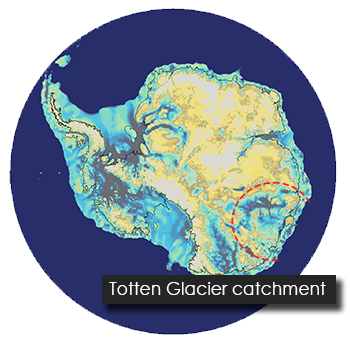
(Totten glacier outflow zone covers a massive region of East Antarctica. An area about equivalent in size to the entire US Southeast region. Warm water is starting to encroach upon an ice shelf locking this great ice mass into its Continental Catchment Basin. Image source: Australian Antarctic Division.)
Totten
already hosts one of the most rapid thinning rates in East
Antarctica. And, in fact, it was a satellite detection of this very
thinning that set off a recent scientific investigation of the
glacier’s stability. What the
new scientific report
identified was a threat that enhanced warm water upwelling from a
human-heated circumpolar current would collide with an ice structure
that is already vulnerable to melt.
The
net result would mean a destabilization and acceleration of one of
the greatest ice masses on the planet. Such an event would have
far-reaching implications, especially relating to the pace and end
state of warming-related global sea level rise.
"Totten
Glacier… has the largest thinning
rate in East Antarctica.
Thinning may be driven by
enhanced basal melting…
Warm modified Circumpolar Deep
Water,
which has been linked to glacier retreat in West Antarctica, has
been observed in summer and winter on the nearby continental shelf
beneath 400 to 500 m of cool Antarctic Surface Water…We
identify entrances to the ice-shelf cavity below depths of 400 to 500
m that could allow intrusions of warm water
if the vertical structure of inflow is similar to nearby
observations. Radar sounding reveals a
previously unknown inland trough that connects the main ice-shelf
cavity to the ocean.
If thinning trends continue, a
larger water body over the trough could potentially allow more warm
water into the cavity, which may, eventually, lead to destabilization
of the low-lying region between Totten Glacier and the similarly deep
glacier flowing into the Reynolds Trough".
(emphasis added)
At
issue are two pathways for this upwelling, warm, deep water to
follow:
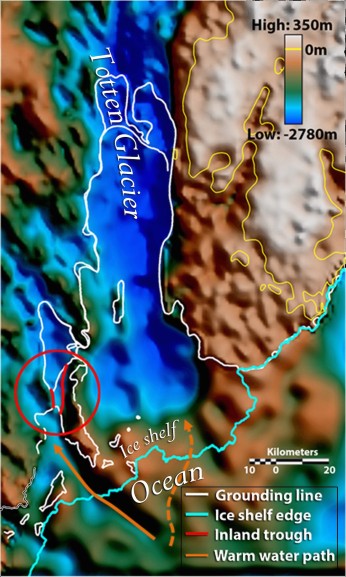
(Topographic map of the Totten Glacier outlet region and nearby seabed. Note the vulnerable water inlets [orange lines], the inland troughs and basins [red highlights and blue topographic signature] and the rather advanced inland extent of the grounding line [white line]. Image source: Ocean Access to a Cavity Beneath Totten Glacier.)
The
pathways are identified by the orange lines in the topographic image
above. The lines identify underwater valleys that run out to the
deeper, warmer waters accumulating on the edge of the Antarctic
Continental Shelf region. As the waters rise, scientists are
concerned that these troughs will act like channels, funneling a
flood of much warmer than normal water beneath the belly of the great
glacier.
The
result is an instance of ‘global consequence.’ The authors note:
We
estimate that at least 3.5 m of
eustatic sea level potential drains through Totten Glacier,
so coastal processes in this
area could have global consequences.
Indeed.
If we add in all the other destabilized glaciers around the world to
Totten, should it destabilize, you end up with about 26 feet of sea
level rise locked in. And that has some pretty staggering
consequences when you look at impacts to the world’s coastlines.
This
is what 20 feet of sea level rise impact looks like for the US
Southeast and Gulf Coasts:
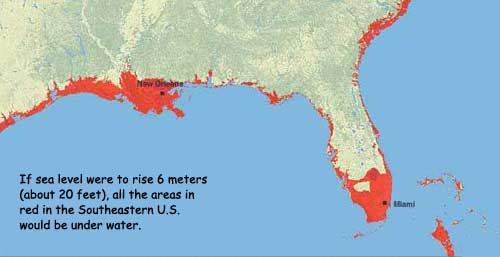
(Six meters of sea level rise would permanently inundate many of the major cities along the US Gulf and Southeastern coasts. Areas inundated shown in red. Image source: NASA.)
But,
perhaps worst of all, is the fact that some of the world’s longest
lasting and most stable accumulations of frozen water are now under
threat of melt.
In
essence, what we are witnessing is possible initiation of the end of
the greatest and oldest ice province on Earth. East Antarctica
glaciated 35 million years ago, when atmospheric CO2 levels fell
below a range of 500-600 parts per million, and has been mostly
stable or growing ever since. Now that region of ice, the most
ancient remaining in the memory of Earth, is under threat. With human
greenhouse gasses in the range of 484 ppm CO2e (CO2 equivalent) and
400 ppm CO2 and rising, it appears that even the oldest glaciers are
under existential threat.
“..the
stage is set. You have a submarine glacier and a deep trough. The
warm water is not too far from that frontal region and we’ve seen
some changes in the glaciers that suggest that something is happening
at their base.”
Links:
A
Glacier Area the Size of the Entire South is Melting Away
“If there is
magic on this planet, it is contained in water.”
–Loren Eiseley
* * * *
Dear Friends,
Today I will be chatting with Caroline Casey at KPFA Radio, Berkley, FM 94.1 on the Visionary Activist Show at 5 PM Eastern, 2 PM West Coast on the issue of climate change, how it impacts the world’s waters and related geophysical systems, and on the broader impact to the Earth’s life supports.
I invite you to listen or to check out the program here.
As a prelude to the discussion with Caroline, I’d like to also provide these thoughts on the issue of how human movement toward a hothouse state is greatly bestirring the world’s waters:
Water is at the center of the climate change crisis. Too much water in the form of persistent rains, or rains that come all at once — with seasonal rains falling in the span of a month, a week, or even a day. Too much water in the form of sea level rise that has already driven 100,000 people away from their Indus River Delta farms due to salt table rise and flooding. Too much water for my home town of Hampton Roads which sees 77,000 properties in flood prone areas now uninsurable except by FEMA. Too much water for Miami which now imposes a fee (essentially an addition to property tax) to pay for increasingly powerful and elaborate pumps to keep the water out of roads, yards, and basements.
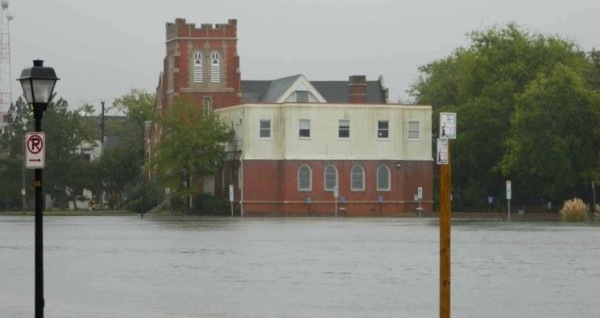
(Unitarian Church of Norfolk, VA. A place my wife and I attended while living in the region some years back. Due to rising sea levels, the Church now regularly floods at high tide. Image source: Campaign to Move the Church to Higher Ground.)
* * * * *
Too little water in the form of an ongoing, now decadal, Southwestern US drought. Too little water for the clear cut and rapidly warming Amazon Rainforest and regions south like Sao Paulo. Far too little water for poor Syria which saw a 7 year drought before destabilization. Perhaps too little water for India and Southeast Asia this year as a combined human warmed ocean, strong PDO, and El Nino threaten to weaken or shut down the annual monsoon.
Too much increase in the flows of water from land to air, called the hydrological cycle in science, that increases the rate of evaporation, making droughts more suddenly intense, and increases the intensity of downpours — which is a brutal blow to vegetation and our ability to capture and use water for human efforts. And all that extra water in the airs and atmosphere thickens the lower zones, likely leading to strange changes like the advent of towering, bullying, blocking high pressure systems (Stu Ostro) or contributing to the powerful wind flows from south to north, from tropics to the Arctic (Jennifer Francis).
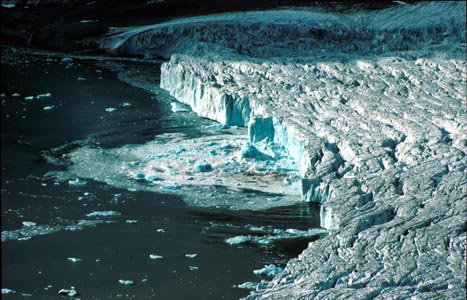
(Glacier calving into dark waters. For reference, the glacier front here is hundreds of feet in height. Image source: Norwegian Polar Institute.)
Changes in the way the Earth holds and manages water also arise. The great ice sheets, for so long dormant in their eons old rumbling, have been awakened by heat and are surging toward the oceans in a great melt that has now doubled in size for each of the past five years since the late 1990s. Great flows that have backed up some of the great ocean currents, causing water to slosh up on coastlines, and painting an expanding pall of fresh water over the Southern Ocean. A lid that risks the locking in of oxygen and a shutting down of the life generation process that has made our oceans so vital for so long.
If we were to translate our scientific knowledge into the language of the ancients, we would say now that water — a spirit that is able to hold the greatest heat of any of the elements — has been made angry by our excess and it is now moving about in our world with an increasing fury.
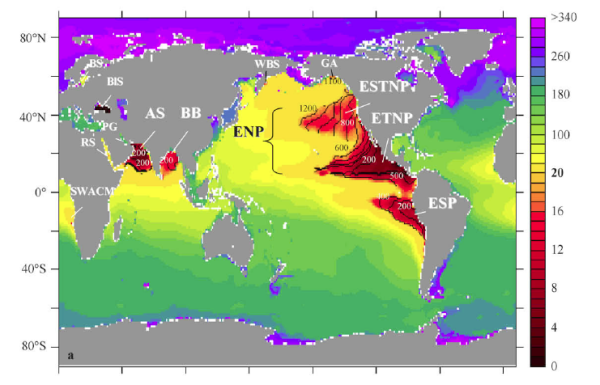
(Expanding low oxygen ocean zones is a real killer — first reducing ocean productivity and then becoming a haven for deadly hydrogen sulfide producing bacteria. A low oxygen ocean can rapidly shift into a deadly state known as a Canfield Ocean. Image source: Oxygen Minimum Zones.)
In the far north, water is forming into lens like lakes in the tundra. These heat trapping engines accelerate the permafrost melt and unlock ancient methane, breathing it into the air and contributing to human warming. In some cases, perhaps, rivers upon the tundra have tunneled down through new-found cracks and encountered ancient water-methane. A frozen fire water under high pressure that when warmed appears to have blown up into large eruptive holes. The tundra blow holes we have seen so much controversy over in the news.
Water in the air, in the oceans, in the ice, in and upon the ground is what makes Earth so bountiful and life-rich. But we are adding heat to that water and so we our changing our relationship with both it and the Earth…
* * * * *
To these points, Caroline asks:
“What lest we die to lest we die from?”
Certainly a notion well worth considering at this rather late hour.
Hat tips to:
Eleggua for facilitating this interview!
Kevin Jones for deep and clear thoughts
Angry Waters: The Human Hothouse vs the Imperative to Preserve Life
20 March,
2015
* * * *
Dear Friends,
Today I will be chatting with Caroline Casey at KPFA Radio, Berkley, FM 94.1 on the Visionary Activist Show at 5 PM Eastern, 2 PM West Coast on the issue of climate change, how it impacts the world’s waters and related geophysical systems, and on the broader impact to the Earth’s life supports.
I invite you to listen or to check out the program here.
As a prelude to the discussion with Caroline, I’d like to also provide these thoughts on the issue of how human movement toward a hothouse state is greatly bestirring the world’s waters:
Water is at the center of the climate change crisis. Too much water in the form of persistent rains, or rains that come all at once — with seasonal rains falling in the span of a month, a week, or even a day. Too much water in the form of sea level rise that has already driven 100,000 people away from their Indus River Delta farms due to salt table rise and flooding. Too much water for my home town of Hampton Roads which sees 77,000 properties in flood prone areas now uninsurable except by FEMA. Too much water for Miami which now imposes a fee (essentially an addition to property tax) to pay for increasingly powerful and elaborate pumps to keep the water out of roads, yards, and basements.

(Unitarian Church of Norfolk, VA. A place my wife and I attended while living in the region some years back. Due to rising sea levels, the Church now regularly floods at high tide. Image source: Campaign to Move the Church to Higher Ground.)
* * * * *
Too little water in the form of an ongoing, now decadal, Southwestern US drought. Too little water for the clear cut and rapidly warming Amazon Rainforest and regions south like Sao Paulo. Far too little water for poor Syria which saw a 7 year drought before destabilization. Perhaps too little water for India and Southeast Asia this year as a combined human warmed ocean, strong PDO, and El Nino threaten to weaken or shut down the annual monsoon.
Too much increase in the flows of water from land to air, called the hydrological cycle in science, that increases the rate of evaporation, making droughts more suddenly intense, and increases the intensity of downpours — which is a brutal blow to vegetation and our ability to capture and use water for human efforts. And all that extra water in the airs and atmosphere thickens the lower zones, likely leading to strange changes like the advent of towering, bullying, blocking high pressure systems (Stu Ostro) or contributing to the powerful wind flows from south to north, from tropics to the Arctic (Jennifer Francis).

(Glacier calving into dark waters. For reference, the glacier front here is hundreds of feet in height. Image source: Norwegian Polar Institute.)
Changes in the way the Earth holds and manages water also arise. The great ice sheets, for so long dormant in their eons old rumbling, have been awakened by heat and are surging toward the oceans in a great melt that has now doubled in size for each of the past five years since the late 1990s. Great flows that have backed up some of the great ocean currents, causing water to slosh up on coastlines, and painting an expanding pall of fresh water over the Southern Ocean. A lid that risks the locking in of oxygen and a shutting down of the life generation process that has made our oceans so vital for so long.
If we were to translate our scientific knowledge into the language of the ancients, we would say now that water — a spirit that is able to hold the greatest heat of any of the elements — has been made angry by our excess and it is now moving about in our world with an increasing fury.

(Expanding low oxygen ocean zones is a real killer — first reducing ocean productivity and then becoming a haven for deadly hydrogen sulfide producing bacteria. A low oxygen ocean can rapidly shift into a deadly state known as a Canfield Ocean. Image source: Oxygen Minimum Zones.)
In the far north, water is forming into lens like lakes in the tundra. These heat trapping engines accelerate the permafrost melt and unlock ancient methane, breathing it into the air and contributing to human warming. In some cases, perhaps, rivers upon the tundra have tunneled down through new-found cracks and encountered ancient water-methane. A frozen fire water under high pressure that when warmed appears to have blown up into large eruptive holes. The tundra blow holes we have seen so much controversy over in the news.
Water in the air, in the oceans, in the ice, in and upon the ground is what makes Earth so bountiful and life-rich. But we are adding heat to that water and so we our changing our relationship with both it and the Earth…
* * * * *
To these points, Caroline asks:
“What lest we die to lest we die from?”
Certainly a notion well worth considering at this rather late hour.
Hat tips to:
Eleggua for facilitating this interview!
Kevin Jones for deep and clear thoughts



No comments:
Post a Comment
Note: only a member of this blog may post a comment.